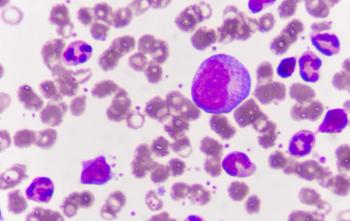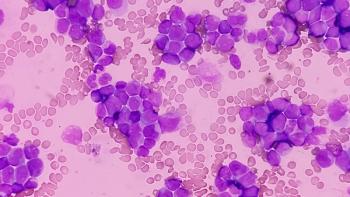
Navitoclax Significantly Reduces Spleen Volume in Myelofibrosis
Adding navitoclax to ruxolitinib improved spleen volume reduction, but not total symptom score in patients with myelofibrosis.
For patients with myelofibrosis, the addition of navitoclax to ruxolitinib (Jakafi) was associated with a significant improvement in spleen volume reduction by week 24 (SVR35W24), but not a significant improvement in total symptoms score (TSS), according to findings from the phase 3 TRANSFORM-1 study (NCT04472598) presented at the
After a median follow-up of 14.9 months (range, 0.0-29.5), navitoclax and ruxolitinib elicited a SVR35W24 for 63.2% of patients compared with 31.5% for placebo plus ruxolitinib, marking a significant overall difference of 31.0% (95% CI, 19.5%-42.5%; P <.0001). At week 24, there was a mean -9.7 change in TSS with navitoclax/ruxolitinib from baseline (95% CI, -11.8 to -7.6) compared with a change of -11.1 for placebo plus ruxolitinib (95% CI, -13.2 to -9.1), which was not statistically significant (P = .2852).
“The spleen volume reduction was doubled and highly statistically significant. There’s no question there, but for the secondary end point, the total symptom score, both groups have the reduction, but it was not statistically significant,” said lead investigator Naveen Pemmaraju, MD, Department of Leukemia at The University of Texas MD Anderson Cancer Center in Houston. “There may be multiple reasons for that. Ruxolitinib alone is a nice drug for symptom improvement, but when you add in a second drug, you're improving the outcomes for the patient but maybe introducing a bit more toxicity. The statistical significance may not have come out because of that.”
Oral navitoclax is a BCL-XL, BCL-2, and BCL-W inhibitor, which may impart unique efficacy for myeloproliferative neoplasms (MPN). “It turns out in MPN and myelofibrosis that the BCL-XL pathway appears to be a bit more important than the BCL-2,” said Pemmaraju. “In myelofibrosis, BCL-XL appears to be upregulated and so in vitro studies showed that either the navitoclax by itself or even better in combination with the ruxolitinib can overcome JAK resistance and add benefit.”
In the combination arm, navitoclax was administered at a starting dose of 200 mg if platelet counts were above 150 x 109 per liter or, if not, at 100 mg, which was later escalated to 200 mg if tolerated and after platelet counts reached greater than 75 x 109 per liter. This methodology was implemented to avoid thrombocytopenia, which was observed in earlier trials with the agent. Ruxolitinib was administered at the standard dose in each arm, although Pemmaraju noted with necessary dose reductions the relative dose intensity was lower. There were 125 patients in the combination arm and 127 in the control group.
In the combination arm, the median age of patients was 70 years (range, 42-87) compared with 69 years (range, 37-85) in the control group. The time from diagnosis to study entry was 8 months (range, 0.3-181.6) in the combination arm and 6 (range, 0.3-198.8) in the control group. Most patients had primary myelofibrosis, at 50% in the investigational arm and 57% in the control group. Other types included transformed version of myelofibrosis, namely those post polycythemia vera and post-essential thrombocythemia. The median spleen volume at entry was 1441 cm3 (range, 419-8020) in the combination group and 1639 cm3 (range, 219-5664) in the control arm.
The median TSS in the combination arm was 21 (range, 0.1-60.6) compared with 24 (range, 6.7-61.6) in the control group. A minority of patients were transfusion dependent at baseline, at 4% in the combination group and 3% in the control arm. The most common risk score was intermediate-2, at 83% in the combination group and 87% in the control. JAK2 V617F was the most common driver mutation, with approximately two-thirds having this mutation in each group. Nearly half of patients had mutations associated with high molecular risk. “These high molecular risk mutations are very important,” said Pemmaraju. “Earlier studies may not have captured this, and we were fortunate to capture this in the majority of patients.”
There was a significantly higher rate of SVR35 with the combination at all time points throughout the study. Across the full-time scale of the study, 76.8% of those in the combination arm experienced a SVR35 compared with 41.7% with ruxolitinib plus placebo, which was a meaningful 34.6% reduction (95% CI, 23.6%-45.6%; P <.0001). The median time to first SVR35 response was similar between groups, at 12.3 (range, 10.1-48.3) vs 12.4 (range, 11.3-72.3) weeks, for the combination and control arms, respectively. Fewer patients lost SVR35 in the combination group (18.8%) compared with the control arm (26.4%). Nearly three-fourths of patients had a 12-month duration of SVR35 in each arm (76.7% vs 76.9%, combination and control, respectively).
The rate of any grade adverse effect (AE) was common between arms, with more patients in the combination arm having a grade 3 or higher AE (85% vs 70%). The most common grade 3 or higher AEs in the combination vs control arms, respectively, were thrombocytopenia (51% vs 15%), anemia (46% vs 39%), and neutropenia (38% vs 4%). For all grade events, diarrhea was more commonly seen with the combination vs control (34% vs 14%). Serious AEs were less common with the combination at 26% compared with 32% for the control arm. AEs that led to dose reduction or dose interruption were twice as common in the combination arm.
“Importantly, dose reductions and interruptions were mostly due to the thrombocytopenia, but importantly none of those were due to clinical bleeding,” said Pemmaraju.
In 2022, AbbVie, the company developing navitoclax noted plans for a submission to the FDA in 2023, pending pivotal study results.2 At this time, the agent is not approved.
References
- Pemmaraju N, Mead AJ, Somervaille T, et al. Transform-1: a randomized, double-blind, placebo-controlled, multicenter, international phase 3 study of navitoclax in combination with ruxolitinib versus ruxolitinib plus placebo in patients with untreated myelofibrosis. Blood. 2023;142(suppl 1):620.doi:10.1182/blood-2023-173509
- AbbVie presents positive investigational navitoclax combination data in phase 2 REFINE study suggesting anti-fibrosis activity for patients with myelofibrosis. News release. AbbVie. April 12, 2022. Accessed December 10, 2023. https://news.abbvie.com/2022-04-12-AbbVie-Presents-Positive-Investigational-Navitoclax-Combination-Data-in-Phase-2-REFINE-Study-Suggesting-Anti-Fibrosis-Activity-for-Patients-with-Myelofibrosis
Newsletter
Knowledge is power. Don’t miss the most recent breakthroughs in cancer care.
















































































